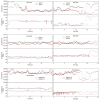Explanation of the Formation of Complexes between Representatives of Oxazolidinones and HDAS-β-CD Using Molecular Modeling as a Complementary Technique to cEKC and NMR
- PMID: 34281189
- PMCID: PMC8268345
- DOI: 10.3390/ijms22137139
Explanation of the Formation of Complexes between Representatives of Oxazolidinones and HDAS-β-CD Using Molecular Modeling as a Complementary Technique to cEKC and NMR
Abstract
Molecular modeling (MM) results for tedizolid and radezolid with heptakis-(2,3-diacetyl-6-sulfo)-β-cyclodextrin (HDAS-β-CD) are presented and compared with the results previously obtained for linezolid and sutezolid. The mechanism of interaction of chiral oxazolidinone ligands belonging to a new class of antibacterial agents, such as linezolid, tedizolid, radezolid, and sutezolid, with HDAS-β-CD based on capillary electrokinetic chromatography (cEKC), nuclear magnetic resonance (NMR) spectroscopy, and MM methods was described. Principles of chiral separation of oxazolidinone analogues using charged single isomer derivatives of cyclodextrin by the cEKC method were presented, including the selection of the optimal chiral selector and separation conditions, complex stoichiometry, and binding constants, which provided a comprehensive basis for MM studies. In turn, NMR provided, where possible, direct information on the geometry of the inclusion complexes and also provided the necessary structural information to validate the MM calculations. Consequently, MM contributed to the understanding of the structure of diastereomeric complexes, the thermodynamics of complexation, and the visualization of their structures. The most probable mean geometries of the studied supramolecular complexes and their dynamics (geometry changes over time) were determined by molecular dynamics methods. Oxazolidinone ligands have been shown to complex mainly the inner part of cyclodextrin, while the external binding is less privileged, which is consistent with the conclusions of the NMR studies. Enthalpy values of binding of complexes were calculated using long-term molecular dynamics in explicit water as well as using molecular mechanics, the Poisson-Boltzmann or generalized Born, and surface area continuum solvation (MM/PBSA and MM/GBSA) methods. Computational methods predicted the effect of changes in pH and composition of the solution on the strength and complexation process, and it adapted the conditions selected as optimal during the cEKC study. By changing the dielectric constant in the MM/PBSA and MM/GBSA calculations, the effect of changing the solution to methanol/acetonitrile was investigated. A fairly successful attempt was made to predict the chiral separation of the oxazolidinones using the modified cyclodextrin by computational methods.
Keywords: NMR; chiral cEKC; molecular modeling; non-covalent interactions; oxazolidinone.
Conflict of interest statement
The authors have declared no conflict of interest.
Figures





Similar articles
-
Enantioselective recognition of sutezolid by cyclodextrin modified non-aqueous capillary electrophoresis and explanation of complex formation by means of infrared spectroscopy, NMR and molecular modelling.J Pharm Biomed Anal. 2019 May 30;169:49-59. doi: 10.1016/j.jpba.2019.02.033. Epub 2019 Feb 21. J Pharm Biomed Anal. 2019. PMID: 30836246
-
Chiral separation of tedizolid using charge single isomer derivatives of cyclodextrins by capillary electrokinetic chromatography.J Pharm Biomed Anal. 2016 Feb 20;120:402-12. doi: 10.1016/j.jpba.2015.11.022. Epub 2015 Dec 24. J Pharm Biomed Anal. 2016. PMID: 26724911
-
Enantioselective recognition of radezolid by cyclodextrin modified capillary electrokinetic chromatography and electronic circular dichroism.J Pharm Biomed Anal. 2017 May 30;139:98-108. doi: 10.1016/j.jpba.2017.01.041. Epub 2017 Feb 21. J Pharm Biomed Anal. 2017. PMID: 28279932
-
Chiral Separation of Oxazolidinone Analogs by Capillary Electrophoresis Using Anionic Cyclodextrins as Chiral Selectors: Emphasis on Enantiomer Migration Order.Molecules. 2023 Jun 2;28(11):4530. doi: 10.3390/molecules28114530. Molecules. 2023. PMID: 37299005 Free PMC article. Review.
-
Single isomer cyclodextrins as chiral selectors in capillary electrophoresis.J Chromatogr A. 2020 Sep 13;1627:461375. doi: 10.1016/j.chroma.2020.461375. Epub 2020 Jul 5. J Chromatogr A. 2020. PMID: 32823120 Review.
Cited by
-
A Review of Machine Learning and QSAR/QSPR Predictions for Complexes of Organic Molecules with Cyclodextrins.Molecules. 2024 Jul 2;29(13):3159. doi: 10.3390/molecules29133159. Molecules. 2024. PMID: 38999108 Free PMC article. Review.
References
-
- ClinicalTrials.gov. [(accessed on 12 May 2021)]; Available online: https://clinicaltrials.gov/ct2/results?cond=&term=sutezolid&cntry=&state...
-
- The PEW Charitable Trusts Antibiotics Currently in Global Clinical Development. [(accessed on 12 May 2021)]; Available online: https://www.pewtrusts.org/en/research-and-analysis/data-visualizations/2....
MeSH terms
Substances
Grants and funding
LinkOut - more resources
Full Text Sources

